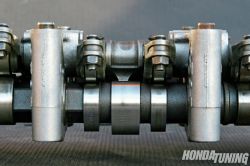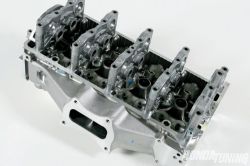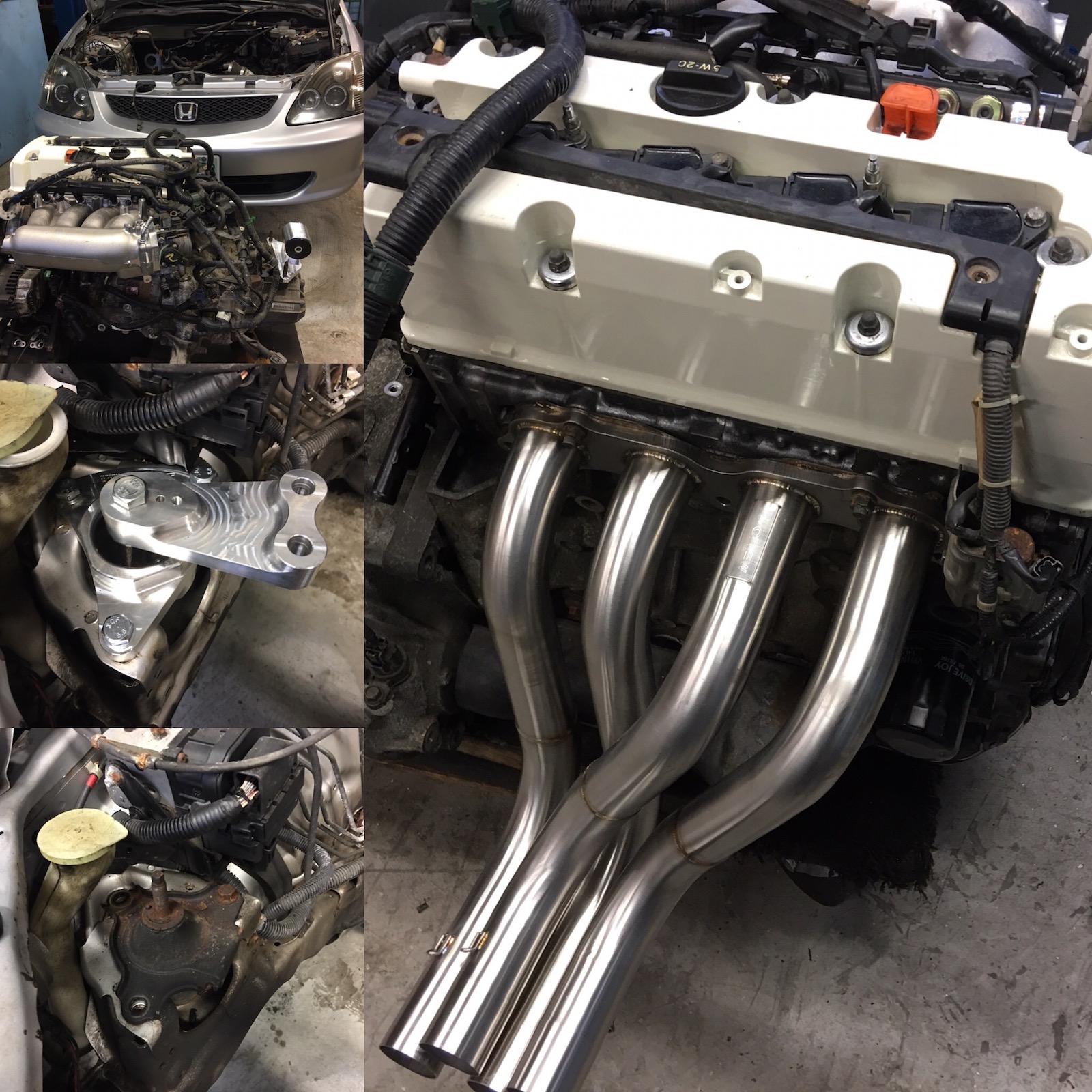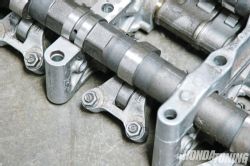
Specializing in the service of honda & acura...
*Honda Racing*The power of Drewms*





K-Series Engine Family Breakdown - K-Series Refresher
It's been more than a decade since Honda introduced its K-series engine family and a lot's changed since then. What was first met with resentment from Honda fans all-too complacent with B18Cs and LS-VTECs has developed into it becoming the engine of choice, especially for naturally aspirated hard-liners who pine for cubic inches and a modernized valvetrain. Thirteen years later, though, and there's a whole lot of K-series engines to sort through, which can make choosing the right one downright baffling. You don't need to be told that not all K-series engines are the same. Pick the wrong one and you might have been better off putting up with whatever B-series you've shunned as its predecessor. And none of this has ever been more true than now, especially when considering Honda's new fleet of K-series engines that care more about reduced emissions and fuel consumption than they do horsepower and upgradability. Follow along as we break down Honda's most popular K-series powerplants, from past to present.

LET US TAKE CARE OF ALL THE MAINTENANCE ON YOUR HONDA OR ACURA!
and/or Performance needs. Schedule an appointment with
WAS Performance Right Now !
K-Series Development
But first, a little history. We Americans were first introduced to the K-series with the help of the 2002 RSX, Civic Si, and CR-V. Following a 12-year reign, the B-series was finally nixed and, in late-2001, replaced with the then-unfamiliar K20A2, K20A3, and K24A1. The new platform's most notable differences when compared to previous four-cylinder Honda mills is its direct-fire ignition system, reverse layout, and clockwise rotation. To improve catalytic converter light-off by positioning the engine's exhaust side toward the rear of the vehicle, Honda developed a clockwise-rotating architecture, which is a whole lot different than the decades worth of counter-clockwise-rotating engines the company's become famous for. The number of K-series engine designations aren't few, but fortunately almost all of them can be traced back to Honda's initial K20A2 and K20A3. Although similar in many respects and both featuring Intelligent Variable Valve Timing and Lift Electronic Control (i-VTEC), the engines' valvetrains and VTEC implementation are where they differ most.
K-20A
2002-2004 RSX Type-S: 200 hp, 142 lb-ft torque The most established of K-series engines, the K20A2 is based off of an all-aluminum block and DOHC, 16-valve cylinder head. Compared to economy-minded K-series engines, the K20A2 features larger intake and exhaust ports, a higher, 11.0:1 compression ratio, and a single-stage aluminum intake manifold that's designed for top-end performance. As is the case with all performance i-VTEC engines, a stiffer, cast-aluminum oil pan is also incorporated that increases overall rigidity.
K20Z1
2005-2006 RSX Type-S: 210 hp, 143 lb-ft torque As Acura performed its mid-model refresh on its RSX, a revised K20Z1 was placed underneath its hood for the model's final two years of production. Generally speaking, there isn't much difference between the K20A2 and the K20Z1 other than slightly more aggressive camshafts, a higher-flowing catalytic converter, as well as a larger intake duct and exhaust, which altogether net another 10 horsepower.
K24A2
2004-2005 TSX: 200 hp, 166 lb-ft torque 2006-2008 TSX: 205 hp, 164 lb-ft torque Honda began producing 2.4L K-series engines for the 2002 model year but didn't release a proper performance i-VTEC version to the United States until the TSX was unveiled. Unlike the K20A's square-bore configuration, 2.4L K-series engines feature a significantly longer 99mm stroke, a 1mm larger bore and, in the case of the K24A2, a lower, 10.5:1 compression ratio. What's more, 2.4L K-series engines are the largest four-cylinders the company's ever produced. Compared to other North American-spec 2.4L K-series engines, the K24A2's internals were made stronger in order to cope with its higher redline, and like most other 2.4L K-series engines, its crankshaft girdle is slightly thicker than those found in 2.0L engines. Like all 2.4L K-series engines, the K24A2's oil pump is counter-balanced, making it less effective at higher engine speeds. Fortunately, the K20A2 oil pump transfers over relatively easily following slight modifications made to it in order to clear the K24A2's thicker crankshaft girdle. Up top, all K24A2s feature cylinder heads similar to other performance i-VTEC engines but with slightly narrower ports that yield increased air velocity. All K24A2 engines also feature single-stage aluminum intake manifolds with long, narrow runners, and drive-by-wire throttle bodies. Several changes for the 2006 model year, like 1 mm larger intake valves and a higher-lift, longer-duration intake camshaft that's arguably better than some Type R camshafts, result in an additional 5 hp. Other mid-model changes include even stronger connecting rods, a more thoroughly counterweighted crankshaft, and additional oil passages within the block, which help reduce windage. A larger throttle body and freer flowing exhaust components were also added.
Performance I-Vtec
Unofficially known as performance i-VTEC, such engines feature Honda's most impressive valvetrain to date. At the heart is something you've heard of: VTEC. Like its predecessors, inside the cylinder head lies Honda's hydraulically operated variable valve timing system. Simple and elegant, VTEC allows the engine to alternate between two different camshaft profiles depending on various conditions. In terms of i-VTEC engines, though, there's more, and it's called Variable Timing Control (VTC). Here, a specialized camshaft gear allows for continuously variable intake camshaft phasing throughout the RPM range. Based upon all sorts of things that the driver needn't worry about, like camshaft position, ignition timing, exhaust oxygen content, and throttle position, a 50-degree range of camshaft phasing can occur (25-degree range on K24A2). Much like VTEC, the camshaft gear is electronically controlled and hydraulically driven, resulting in reduced timing at idle and advanced timing at higher engine speeds, which increases valve overlap and power. Fittingly, the "i" in i-VTEC stands for intelligent and, together, VTEC and VTC offer an unprecedented balance between performance and emissions. The advantages up top span beyond the valvetrain. In terms of airflow, performance i-VTEC cylinder heads shame even the best of B-series top ends. This is, in part, due to oversized valves—2 mm larger than B-series VTEC engines. Performance i-VTEC engines also feature more optimally shaped intake and exhaust ports when compared to the B-series and larger ports when compared to other K-series engines. On the intake side, they form a nearly straight path. On the exhaust side, they're free of the humps typically found within B-series ports. K-series engines also benefit from sophisticated roller rocker arms, which reduce valvetrain friction and allow for all manner of billet camshafts. This is in stark contrast to older Honda engines that feature standard, pad-style rocker arms. Down below, every 2.0L engine features a 86mm bore and 86mm stroke. Also known as a square design, such engine architectures are a good compromise between decent low-end torque and adequate top end power. The 2.4L engine's over-square design, which features a longer stroke and slightly larger bore, results in more torque, but at the expense of any additional top end power. In terms of crankshafts, each is forged from high-quality steel, but only performance i-VTEC versions feature a fully counter-weighted design. Performance i-VTEC engines also feature under-piston oil squirters for increased cooling, stronger connecting rods and, generally, higher-compression pistons. In terms of North American-spec and Japanese-spec K-series engines, the K20A2, K20Z1, K20Z3, K24A2, K20A, and K24A all share a similar i-VTEC architecture. Although engine geometry and ancillaries such as intake manifolds, throttle bodies, and exhaust manifolds may differ between them, they all share more in common than not and make up some of the most desirable K-series engines.
K20Z3
2006-2011 Civic Si: 197 hp, 139 lb-ft torque The Si's powertrain is unsurprisingly similar to the K20A2 with the exception of its electronics and ancillaries, the most notable of which are its free-flowing intake manifold and drive-by-wire throttle body. The K20Z3's intake manifold, also known as the RBC manifold, which is indicative of Honda's parts naming system, has gone on to serve as one of the most popular bolt-ons for non-Z3 K-series engines because of its exceptionally short runners, straight-through design, and high-flowing capabilities. K20Z3 engines also feature revised camshaft profiles when compared to older engines as well as internal balance shafts, which, in an effort to minimize engine vibrations, sacrifice a bit of power. The K20Z3 also features a deeper, larger-sumped aluminum oil pan when compared to other K-series engines.
Buyer be Were !! Those Clearance Items All Sale are Final sale, Not refund or exchange allow ! Please send money to our PayPal account @ wghonda@msn.com Items will shipping out within 48 hours after payment is recieved!
W.A.S Copyright©All Rights Reserved 1995-2024.



